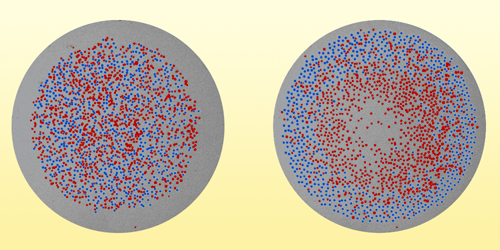Binary Colloids Don’t Flock Together
In nature, different animal species sometimes flock together to suit their collective needs. Zebras often herd with giraffes to benefit from the latter’s vigilance, for example. However, physicists who examine such collections of active particles tend to focus on systems comprising far smaller constituents—typically, collections of identical, micrometer-sized particles, which are rarely found in nature. Samadarshi Maity and Alexandre Morin of Leiden University in the Netherlands now unravel how a two-component system spontaneously demixes [1]. Their investigation is a step toward establishing laws describing how self-propelled particle mixtures self-organize.
The researchers placed a homogeneous suspension of two sizes of dielectric particles in a circular well and applied a uniform electric field. The field caused the particles to roll, and these “colloidal rollers” quickly self-organized into a single flock that processed clockwise or counterclockwise around the well with equal probability. Then came the surprise: the flock spontaneously demixed, with larger particles accumulating toward the well’s edge and smaller ones populating its core.
Maity and Morin determined that the demixing process is governed by a number of competing factors. The fundamental driver is the difference in rolling speed attained by the different-sized particles: faster (larger) rollers are pushed more strongly toward the edge of the well. This effect is countered by an electrostatic repulsion arising from the way the rollers couple to the electric field and undergo charge polarization. Each particle population achieves a unique balance between these forces, determining that population’s distribution within the well. The researchers say that their hydrodynamic model of this self-sorting process could inspire active sorting platforms that rely on constituents’ mobility and interactions.
–Rachel Berkowitz
Rachel Berkowitz is a Corresponding Editor for Physics Magazine based in Vancouver, Canada.
References
- S. Maity and A. Morin, “Spontaneous demixing of binary colloidal flocks,” Phys. Rev. Lett. 131, 178304 (2023).




